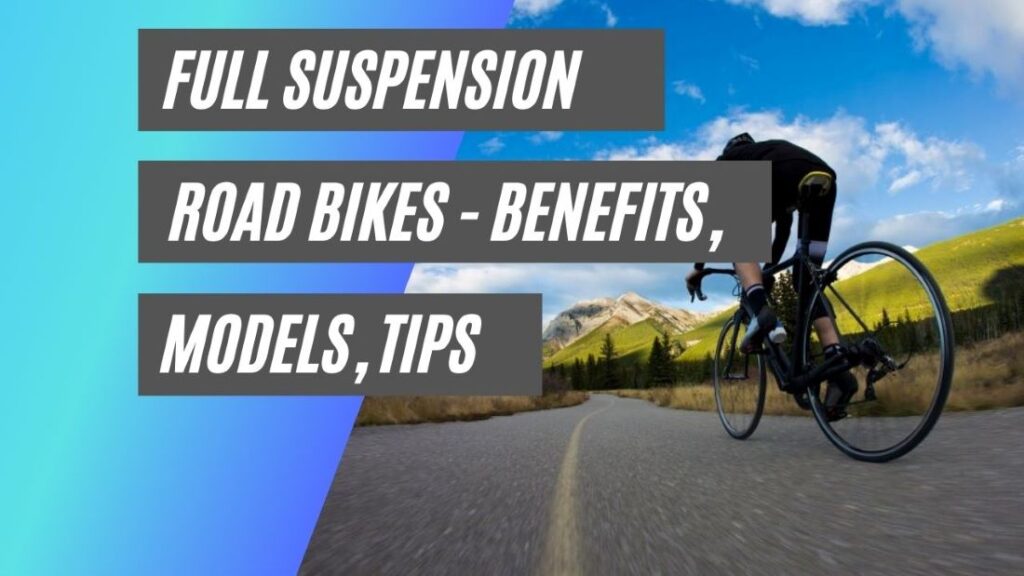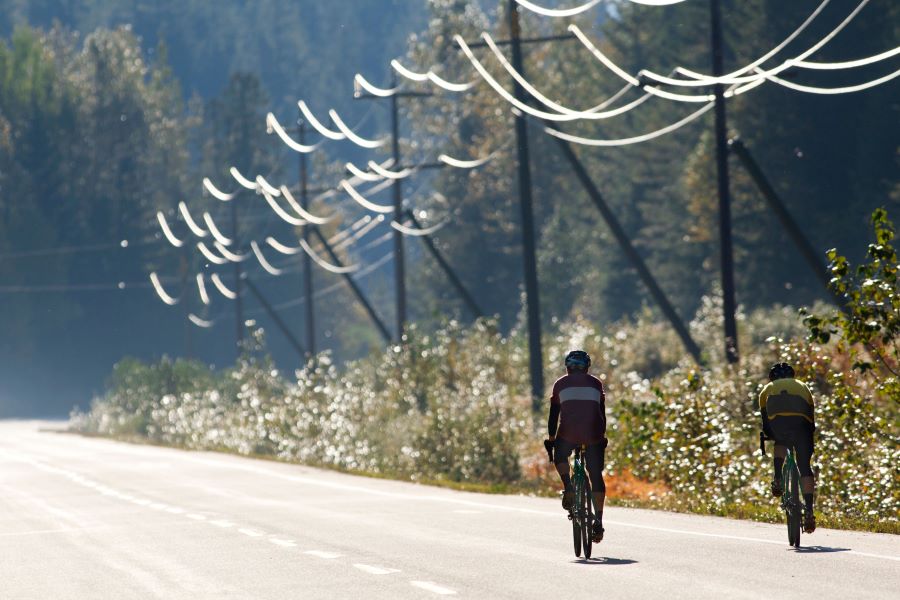This post may contain affiliate links. If you click an affiliate link and make a purchase, I may earn a commission. Also, as an Amazon Associate, I earn from qualifying purchases.--
Full-suspension road bikes are the new hot topic in the cycling world and for all the right reasons. The bike is incorporated with the latest suspension design and the most effective rear shock function to ensure your comfort and safety as you embark on new adventures.
As a biking enthusiast, I completely understand how exhausting (and painful!) it can get after riding over rough terrain.
In this post, I’m going to look at all the benefits of full-suspension bikes, the different types that are on the market, and then give a few tips on how to get the most out of riding one.

What Is A Full-Suspension Road Bike?
Full-suspension road bikes are a perfect companion for your outdoor adventures, equipped with a rear shock and an upfront suspension fork.
Whether you decide to bike cross-country or on rocky terrain, full-suspension road bikes have got you covered.
Moreover, due to technological advancement in recent years, full-suspension road bikes have improved at converting the energy you use to pedal into forward motion. As a result, you will achieve maximum forward motion according to the leg power you put into pedaling (Source).
The shock-absorbing benefits that come along with full-suspension road bikes will provide the comfort that you have been yearning for ages.
Gone are the days when you would tighten the grip of your hand on the handles of the bike as a way to embrace impact. With a full-suspension road bike, you can now ride with ease and comfort regardless of the nature of the road.
Additionally, the comfort that the bike brings will allow you to reduce your fatigue and ride for a more extended period.
Why Should You Buy A Full-Suspension Road Bike In The First Place?
Now you know what a full-suspension road bike is, but then you may be wondering what makes the bike so unique?
The previously discussed features can be found in multiple other cycles, so what makes a full-suspension road bike stand out from the rest?
The simple answer is that the full-suspension road bike will give you comfort without compromising on speed or traction.
Full-suspension road bikes are a complete package as they cater to every need of yours to ensure that you have the best experience whenever you hop on the bike.
The four main benefits that come with riding a full-suspension road bike are:
1. Ideal for People Seeking Comfort
As stated before, full-suspension road bikes are the most comfortable road bikes present in the current market. Its ability to absorb shock allows it to protect your arms and feet from the impact.
As a result, you will feel less fatigue during your ride and will be able to explore the terrain further (Source).
Moreover, the comfort that comes with a full-suspension road bike will allow you to immerse yourself in the nature that surrounds the trail you ride on; fully enjoying the experience.
2. Better Traction
Traction is a necessary feature that every bike is incomplete without. Due to the presence of front and rear suspension, full-suspension road bikes have the ideal amount of traction that you will need to cycle through any terrain.
Since the tires move vertically to absorb the shock, this means the tire doesn’t get displaced after encountering an irregularity on the road.
Moreover, it lets the tire be more firmly positioned on the trail resulting in better traction. Whenever the tire does move vertically due to shock, it falls back into its original position, gaining the ideal traction you need for a smooth ride.
This feature makes not only full-suspension road bikes ideal for rocky terrain but for slippery terrain as well.
3. More Control
Traction allows a biker to have more control over the bike. A full-suspension bike will give you the power to ride through any terrain with full speed and flexibility.
Moreover, you can apply brakes or slow the pace of the ride without any delay due to this feature.
The control a full-suspension road bike offers allows you to act according to the situation you face during your ride. The smooth execution of each demand will help you react quickly to your surroundings.
4. Perfect for Rough and Unpredictable Terrain
If the idea of cycling through rocky gardens and uncertain terrains excites you, then the full-suspension road bike is the perfect partner for it.
The rear and front suspensions are meant to endure the shock you may experience as you ride on such terrains.
Extreme comfort level alongside excellent traction will allow you to ride on rough terrains with ease and speed.
Not only this, but it will also give you room to spice up your biking routine by taking more risks and trying out new rocky trails and tricks.
Here’s a table of the pros and cons of road bikes and full-suspension road-bikes to help you decide which is right for you:
| Feature | Road Bike | Full-Suspension Road Bike |
| Speed | Greater speed than full-suspension | Less speed than standard road bike |
| Cycling on rough terrain | Not suitable | Highly suitable |
| Traction | Traction on flat roads | Good traction on a range of surfaces |
| Control | Good control on flat surfaces | Better control on a range of surfaces |

How Many Types Of Full-Suspension Road Bikes Are There?
Before buying a full-suspension road bike, you must know about the different types of bikes the market has to offer.
The bikes are classified into a specific category based on how much the suspension “travels”. In other words, it’s how much the wheel axle moves when the suspension compresses.
These categories are designed to cater to different types of bikers present in the biking community. Short-travel bikes are a perfect match for bikers who are into cross-country riding.
At the same time, medium-travel bikes are ideal for bikers who are into mountain riding.
Last but not least, the long-travel bikes are meant for bikers who enjoy downhill or freeride riding.
However, the information given above is not enough for you to make the best decision on which bike to buy. To ensure you make the correct decision, I will be discussing each type in further detail next.
Short-Travel Bikes
As mentioned previously, bikers usually use short-travel bikes in cross-country riding. The suspension travels about 1-3 inches, making the bike comparatively more rigid than other types.
However, it does provide the necessary comfort you would need while cross-country riding to make sure you can ride smoothly through any terrain you encounter.
Moreover, due to less travel, the weight of the short-travel bike is the lowest out of all three types; a typical short-travel bike weighs around 22 to 28 pounds.
Additionally, the tight geometry of the bike will give you more control over the bike’s movement. It will allow you to make sudden turns and twists according to the terrain you ride on.
I have personally used short-travel bikes for casual strolls and shorter trails. The bike’s comfort allowed me to enjoy my surroundings as I rode on the course.
It is also very responsive to changes in the bike’s movement. Therefore, I recommend you buy a short-travel bike if you plan to ride cross country or enjoy cycling for short distances.
Medium-Travel Bikes
Medium-travel bikes are fantastic for mountain riding and have recently started to gain popularity over it.
4-6 inches of suspension travel provides the ideal stability the bike needs to ride over a rough surface.
They are also equipped with rear shock and forks, making it easier to absorb the shock you may encounter as you make your way towards the mountainous terrain.
Moreover, medium-travel bikes are constructed with more sturdy items and tires. The tires used in a medium-travel bike are thicker than the other full-suspension road bikes.
It provides you with the essential traction you will need to ride over rugged terrain.
Moreover, the bike’s stable geometry and the perfect range for its weight (26-34 pounds) have made it popular among bikers.
Like the others, it would be a lie if I said that I don’t have a bias towards medium-travel bikes. The medium-travel bike is made with the ideal proportions making it the perfect choice for mountain riding or riding over very jagged terrain.
Furthermore, it also provides you with the ideal blend of comfort and traction that will allow you to go a long distance without exhausting yourself.
Long-Travel Bikes
Long-travel bikes are what every freeride or downhill biker dreams to own. With 7-10 inches of travel, you don’t have to worry at all about the huge bumps on the road as the bike’s suspension system has got you covered.
Compared to the medium-travel bike, the components made to create long-travel bikes are sturdier.
Additionally, the tires are wide and have sidewalls around them to improve traction. Not only this, but the bike also comes equipped with a hydraulic disc brake to give you more control over the bike’s speed.
Since long-travel bikes are commonly used by dare-devils who ride through extreme terrains, the bike must have been designed keeping this in mind.
Therefore, the bike comes with a chain guide and chainring to ensure the chain doesn’t fall as you ride over extreme terrains.
Also, the bike’s weight leans more towards the heavier side to provide stability and resistance.
I feel a long-travel bike is a must-have if you’re into extreme sports.
The suspension system present in the bike will protect you from uncertain shocks that come with such terrain. As a result, you will use your energy effectively to travel more.
Tips and Tricks to Tune Your Full-Suspension Road Bike at Its Finest
There is no doubt that full-suspension road bikes perform great compared to their rivals.
However, you must tune the suspension system according to your weight to ensure the bike performs at its utmost potential.
I will list the necessary steps you should take to adjust your bike to perfection.
- The first step is to set your suspension system properly. Every bike manufacturer has guidelines for what adjustments you should make to the front and rear shock according to your weight. These adjustments can be made by adding spring preload to the shock unit or changing the air pressure.
- The last step is to adjust the rebound and compression damping system according to your riding style. Damping is the amount of delay or resistance the shock adds as the tire compresses and rebounds after encountering a bump on the trail. The damping system must be adjusted according to the set guidelines given by the manufacturer to avoid accidents. However, you can tweak it here and there according to your choice.
- Also, don’t forget to check your rear suspension linkage before every ride to ensure your ride goes smoothly.
The Bottom Line
At this point of the article, you have ample information to make the right decision of whether full-suspension road bikes are worth it or not.
It may feel like a hassle to maintain a full-suspension road bike, but considering the features it has to offer, the hassle seems like a minor flaw that can be ignored.
The idea of riding through rocky terrains without compromising on comfort, traction, or speed feels like a dream come true. However, this dream does come with a hefty price tag ranging from $500 to $1500.
But don’t lose hope; you can still buy a good quality second-hand full-suspension road bike on eBay at a reasonable price point. You must consider the product’s price and quality whatever decision you make regarding buying a full-suspension road bike.
